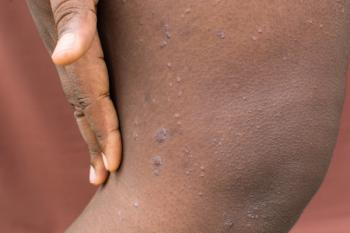
Talquetamab Combo Updates Show Durable Responses in Heavily Pretreated Patients
An oral session Friday at the International Myeloma Society 21st Annual Meeting & Exposition offered updates for the TRIMM-2 and RedirecTT-1 trials.
Talquetamab, the bispecific GPRC5D-directed CD3 T-cell engager, offered durable responses when used in different combinations, according to data from a pair of trials involving patients with multiple myeloma who had received 4 to 5 prior lines of therapy.
Updated phase 1b results were presented early Friday for the TRIMM-2 (NCT04108195) and RedirecTT (NCT04586426) trials at
Talquetamab (Talvey; Johnson & Johnson) was approved August 8, 2023, by FDA for the treatment of relapsed or refractory multiple myeloma in patients who have received at least 4 prior lines of therapy, including a proteasome inhibitor, an immunomodulatory agent, and an anti-CD38 monoclonal antibody.3
TRIMM-2 Update: After Therapies Fail, Work in Triplet
At ASCO 2023, phase 2 results for one arm of TRIMM-2 showed an overall response rate (ORR) of 78% for a combination of talquetamab and subcutaneous daratumumab (Darzalex Faspro, Johnson & Johnson), with 12-month progression-free survival (PFS) at 77.4% among patients taking the larger talquetamab dose (0.8 mg/kg biweekly).1
At IMS 2024, Nizar J. Bahlis, MD, of Arnie Charbonneau Cancer Institute at the University of Calgary presented phase 1b results for a triplet arm, which tested talquetamab, daratumumab, and pomalidomide (Pomalyst, Bristol Myers Squibb) in patients who had taken at least 1 more line of therapy on average than patients in the earlier phase 2 study.4
In this phase 1b study, 93.5% had received an anti-CD38 therapy, with 83.1 refractory (including 80.5% refractory to daratumumab). Also, 83.1.% had received pomalidomide, with 75.3% refractory, and 39.0% had received a bispecific, with 37.7% refractory. In addition, 31.2% had prior treatment with chimeric antigen receptor T-cell therapy.
As in the prior phase 2 study, patients received talquetamab doses of either 0.4 mg/kg weekly or 0.8 mg/kg biweekly. Daratumumab dosing was 1800 mg, with pomalidomide 2 mg, starting at cycle 2.1,4
Results as of April 10, 2024, showed the following:4
- 77 patients received the triplet of talquetamab, daratumumab, and pomalidomide, with a median follow-up of 17.5 months.
- Median prior lines of therapy was 6 over a median of 6.8 years since diagnosis. Most patients were penta-drug exposed (68.8%) and triple-class refractory (77.9%).
- At baseline, 26.2% had high-risk cytogenetic features, and 23.4% had extramedullary disease.
- ORR was 81.8%; 53.2% of patients had a complete response or better. Median duration of response was 22.1 months (95% CI, 13.6–27.0). Median time to first response was 1.0 month, with a range of 0.9–6.7 months. Median PFS was 15.5 months (95% CI, 11.7–24.4).
Bahlis discussed the strengths and prior evidence for each therapy in the triplet in the current study.
“Talquetamab is a first-in-class bispecific antibody that targets an orphan molecule, GPRC5D that is aberrantly expressed on clonal plasma cells as a single agent,” Bahlis said. “It reported high activity with an overall response rate of 70% in the MonumenTAL-1 study. Daratumumab is a first in class anti-CD38 antibody with known direct anti-myeloma activity as well as immunomodulatory effects. Pomalidomide is a third-generation immunomodulator that also has direct anti myeloma activity as well as immunomodulation effect.
“Preclinical studies suggest that the combination of a bispecific antibody with daratumumab or with an immunomodulator have synergistic effects,” Bahlis said.
Investigators described the responses to the triplet as “deep and durable” in anti-CD38 refractory and prior T-cell redirection–exposed patients. Bahlis said responses were consistent among patients despite whatever therapy they may have had in the past, even if they were double refractory.
Adverse events
Despite the success of the trial, 45% of the patients stopped taking 1 of the therapies in week 2. In response to a question, Bahlis delineated that 24 patients stopped taking pomalidomide in week 2, compared with 3 who stopped talquetamab and 5 who stopped daratumumab. He did not have information on what pomalidomide is adding to the regimen available.
All patients had at least 1 adverse event (AE), with 94.8% grade having a grade 3/4 AE. Most common AEs were dysgeusia (79.2%; NA grade 3/4), neutropenia (77.9%; 68.8% gr 3/4), cytokine release syndrome, or CRS (74.0%; all grade 1/2), dry mouth (64.9%; 2.6% grade 3/4), and fatigue (57.1%; 5.2% grade 3/4).
Median onset of CRS was 1 day after receiving talquetamab; median duration was 2 days. Immune effector cell-associated neurotoxicity syndrome (ICANS) occurred in 3.9% (grade 3/4 1.3%). Infections occurred in 74.0% (29.9% grade 3/4); onset of most grade 3 or higher infections occurred within the first 6 months (18/23 events). Two patients died due to AEs; these were sepsis and hemorrhagic transformation stroke.
Investigators concluded that among patients with relapsed/refractory multiple myeloma, the triplet of talquetamab, daratumumab, and pomalidomide was “promising depth and durability of response,” even among patients whose were refractory to daratumumab and pomalidomide in the past.
Based the results, the triplet is being tested in the
RedirecTT-1: Strong Responses in EMD With Dual Bispecific
Prior to its approval of talquetamab, with its anti-GPRC5D mechanism, FDA authorized teclistamab (Tecvayli, Johnson & Johnson), an anti-BCMA CD3 T-cell engager for patients who have received at least 3 prior therapies to treat multiple myeloma. In RedirectTT-1, investigators led by Yael C. Cohen, MD, of Tel Aviv University are examining the potential advantages of combining these mechanisms, especially in high-risk patients.5
"The dual targeting of GPRC5D and BCMA can avoid antigen escape and clonal resistance," Cohen explained.
Earlier work allowed investigators to determine the recommended phase 2 dose of teclistamab at 3.0 mg/kg every 2 weeks and talquetamab at 0.8 mg/kg every 2 weeks.2 Results reported at IMS 2024 updated data from RedirecTT-1 with longer median follow-up, according to the abstract.5
As of March 15, 2024, investigators reported the following results for 94 patients, with 44 patients at recommended phase 2 dose.
- The median follow-up was 20.3 months, and 18.2 months for patients at the recommended dose.
- Median age was 64.5 years.
- Patients had 4 median prior lines of therapy; 86.2% were triple-class refractory and 64.9% were penta-drug exposed.
- Overall, 41.2% (21/51) patients had high-risk cytogenetic features, while 34 (36.2%) had extramedullary disease (EMD), defined as more than 1 bone-independent lesion of at least 2 cm.
- Overall rate of response (ORR) at 18 months for the intent-to-treat population at the recommended dose was 79.5%; among patients with EMD at the recommended dose, it was 61.1%.
- Cohen said durability of response was a defining feature of the combination therapy. The probability of patients at the recommended dose who had response retaining it at 12 months was 91.0%; at 18 months, it was 85.9% for these patients.
- Among patients with EMD at the recommended dose, 81.1% of patients in response retained it at 12 months.
- PFS was 73.7% at 12 months for the recommended dose and 69.8% at 18 months. At 12 months, PFS was 52.9% at the recommended dose for patients with EMD.
- Dose-limiting toxicities occurred in 3 patients across all dose levels; 1 had grade 3 oral herpes, 1 had grade 3 elevated alanine aminotransferase/aspartate aminotransferase, and 1 had grade 4 thrombocytopenia at the recommended dose.
Adverse events
A total of 14 patients (14.9%) died to due AEs; this included 11 due to infection, of which 6 (6.4%) deaths were related to the drug. The most common AE was CRS (78.7%; grade 3, 2.1%; no patient had grade 4/5). Other common AEs were neutropenia (73.4%; grade 3/4, 68.1%), taste changes (64.9%; grade 3/4, not applicable), and non-rash skin AEs (60.6%; no grade 3/4).
Grade 3/4 infections occurred in 63.8% of patients at all dose levels and 47.7% at the recommended dose level. ICANS occurred in 3.2% of patients (none grade 4/5). In total, 15 (16.0%) patients discontinued 1 of the 2 drugs due to AEs, of which 7 (7.4%) were drug-related (5 due to infections).
“This is the first dual-targeting bispecific antibody combination” in relapsed/refractory multiple myeloma, the investigators wrote in the abstract, noting that the combination had a safety profile that was similar with each agent as monotherapy. Reponses to dual bispecific were consistent across doses, with robust durability of response at the recommended dose.
Of note, “efficacy in patients with EMD closely approximates outcomes in all patients, potentially overcoming the poor prognosis in high-risk populations.” The investigators say the results support further study in a larger trial.
Cohen said the results for patients with EMD are highly favorable to anything seen previously. “When you test the new regimen—if you test it against your toughest patients, you can get a true sense of what the potency of this regimen is,” she said. ”So, 81% of the EMD patients remained in response after 12 months; looking at PFS again, similarly, we see here encouraging results in the total population, [with] 69.8% of the patients remain progression free at 18 months.
“With EMD, PFS at 1 year was 52%; if you compare these EMD results to those that have been reported for non-immunotherapeutics and even for monotherapies, with bispecifics and for CAR T, these are far favorable than what has been previously reported," Cohen said.
References
- Dholaria BR, Weisel K, Mateos MV, et al. Talquetamab (tal) + daratumumab (dara) in patients (pts) with relapsed/refractory multiple myeloma (RRMM): Updated TRIMM-2 results. J Clin Oncol. 2023;41(suppl 16):8003. doi:10.1200/JCO.2023.41.16_suppl.8003
- Cohen YC, Morillo D, Gatt ME, et al. First results from the RedirecTT-1 study with teclistamab (tec) + talquetamab (tal) simultaneously targeting BCMA and GPRC5D in patients (pts) with relapsed/refractory multiple myeloma (RRMM). J Clin Oncol. 2023;41 (suppl 16):abstract 8002. doi:10.1200/JCO.2023.41.16_suppl.8002
- FDA DISCO Burst Edition: FDA approvals: Talvey (talquetamab-tgvs) for relapsed, refractory multiple myeloma. News release. FDA. September 28, 2023. Accessed September 27, 2024.
https://www.fda.gov/drugs/resources-information-approved-drugs/fda-disco-burst-edition-fda-approvals-talvey-talquetamab-tgvs-relapsed-or-refractory-multiple - Bhalis NJ, Talquetamab (tal) + daratumumab (dara) + pomalidomide (pom) in patients (pts) with relapsed/refractory multiple myeloma (RRMM): results from the phase 1b TRIMM‑2 study. Presented at: International Myeloma Society 21st Annual Meeting & Exposition; Rio de Janiero, Brazil; September 27, 2024. Abstract OA – 01.
- Cohen YC. Talquetamab (tal) + teclistamab (tec) in patients (pts) with relapsed/refractory multiple myeloma (RRMM): updated phase 1B results from RedirecTT-1 With >1 Year of follow-up. Presented at: International Myeloma Society 21st Annual Meeting & Exposition; Rio de Janiero, Brazil; September 27, 2024. Abstract OA – 03.
Newsletter
Stay ahead of policy, cost, and value—subscribe to AJMC for expert insights at the intersection of clinical care and health economics.








































